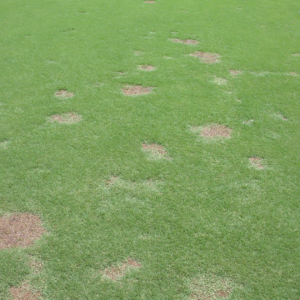Lawn Disease
|
Image
|
Symptoms
|
Treatment
|
Take-All Patch
|
 |
Initially Take-All Patch lawn disease looks like small, light-brown dead patches in the turf. But over time this can spread to over one metre wide.
You can recognise Take-All Patch because the base of the shoots and roots become brownish black before they die.
|
- Lower the pH of your soil to less than 5.5 by applying phosphorous and potassium.
- Water your lawn less and improve the drainage of the soil as Take-All Patch thrives in poorly drained soils.
- If necessary remove the diseased patches and returf.
- Apply a preventative systemic fungicide.
|
Spring Dead Spot
|
 |
Spring Dead Spot lawn disease is typically found often in late winter and spring. It presents as circular, bleached patches which can range from a few centimetres to over one metre in size. |
- Fertilise to maintain nutrition needs.
- Supplement with potassium.
- Improve drainage and phase back the watering as SDS thrives in moist soil.
- Reduce thatch to below 1 cm thickness to alleviate compaction.
- Apply a preventative systemic fungicide.
|
Pythium Blight
|
 |
First appearing as small, irregularly shaped water-soaked spots that range from 10 to 100mm in diameter. Pythium Blight lawn disease then appears as slimy or oily patches which then shrivel. Patches fade to light-brown or grey colour and grow to join together. They may even look like long streaks of affected turf.
It's most easily identified by the white, cottony fungal mycelia that you can see on the surface of the leaves in the morning.
|
- Water deeply but infrequently to reduce waterlogging.
- Reduce thatch to below 1cm thickness to alleviate compaction.
- If necessary, aerate your lawn.
- Pythium blight spreads easily, so clean your lawn mower blades and any other equipment after use.
- Apply a preventative broad spectrum fungicide.
|
Fusarium Patch
|
 |
Initially identifiable by small, round, water-soaked patches less than 5cm in diameter. These range in colour from orange to dark brown to light grey, and usually grow to about 20cm.
Identifiable by the halo-like ring that can appear on the outer edges of infected areas on low-cut turf. Also by the thin covering of white mycelium that turns a pink colour in sunlight.
|
- Ensure you maintain a low soil pH by amending the soil as necessary.
- Increase air circulation through dethatching and aeration.
- Minimise shade.
- Apply a broad spectrum fungicide.
|
Fairy Ring
|
 |
Fairy Ring lawn disease isn’t as nice as it initially sounds. It appears as circular or arc-shaped rings of faster growing turf.
It's easily identifiable by the concentric ring of dead grass that develops inside the circle of fast growing turf. Often accompanied by mushrooms or toadstools.
|
- If there are fungi in place but no accompanying dark grass, simply rake those away and dispose of them.
- If dark grass is present you will also need to remove the turf and root zone with the soil that contains the white, cottony mycelial mass.
- Continue with regular fertilising, mowing, thatch reduction and aeration.
- Apply nitrogen and iron to mask symptoms.
- Use soil wetting agents to penetrate hydrophobic areas.
|
Dollar Spot
|
 |
Like many other lawn diseases Dollar Spot can first appear as small, circular discoloured patches in the lawn. They differ from other lawn diseases by also being slightly sunken.
Often mistaken for drought injury or fertiliser burn, Dollar Spot is identifiable by the bleached lesions that run down the blades of the grass. And when dew is on the grass, cottony threads will appear as well.
|
- Adopt a strong lawn care maintenance program including aeration, thatch and mowing.
- Water deeply but infrequently in the morning.
- Use a preventative fungicide that uses liquid copper or active ingredient propiconazole.
|
Helminthosporium Leaf Spot
|
 |
Of all the lawn diseases this one is the most uniquely identifiable by the small lesions on the leaf blades which causes the leaf to turn yellow. Once they are severely impacted, they die back and take on a straw-like structure.
On some lawn types – for example couch – white or black blotching can appear. And the lesions can look purple-black in colour. On kikuyu the lesions look solid brown to purple coloured as well.
|
- Have a consistent fertilisation process paying close attention to potassium and nitrogen.
- Water infrequently but deeply.
- Mow your lawn regularly to the recommended height for your turf.
- Improve air movement with aeration and dethatching.
- Avoid herbicide applications when the disease is active.
- Apply a preventative fungicide.
|








